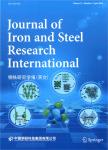Effect of CaO/Al2O3 ratio on viscosity and structure of CaO-Al2O3-based fluoride-free mould fluxes
作者机构:School of Materials Science and EngineeringUniversity of New South WalesSydney 2052Australia Baosteel Group Corporation Research InstituteShanghai 201900China
出 版 物:《Journal of Iron and Steel Research International》 (Journal of Iron and Steel Research, International)
年 卷 期:2019年第26卷第4期
页 面:374-384页
核心收录:
学科分类:0806[工学-冶金工程] 08[工学] 0805[工学-材料科学与工程(可授工学、理学学位)] 0703[理学-化学] 0702[理学-物理学] 0801[工学-力学(可授工学、理学学位)]
基 金:BAJC Baosteel-Australia Joint Research and Development Centre Australian Research Council, ARC University of New South Wales, UNSW China Scholarship Council, CSC
主 题:CaO-Al2O3-based flux CaO/Al2O3 ratio Viscosity Flux structure
摘 要:The effects of CaO/Al2O3 ratio on viscosity and structure of the CaO-Al2O3-based fluoride-free mould fluxes were investigated with the CaO/Al2O3 ratio varied from 1 to 4 and the content of SiO2 fixed at 7 wt.%. The increase in the CaO/Al2O3 ratio from 1 to 2 lowered the viscosity of the flux melts. The viscosity increased slightly with the CaO/Al2O3 ratio from 2 to 3, and this increase became significant with further increasing CaO/Al2O3 ratio to 4. Both break temperature and apparent activation energy were found to be increased with the increase in CaO/Al2O3 ratio from 2 to 4. There was no break temperature available in the flux with CaO/Al2O3 ratio of 1. Changing the CaO/Al2O3 ratio from 1 to 2 decreased the apparent activation energy. Equilibrium phases of the fluxes were calculated using FactSage 7.1 and the major phases were found to be varied with the CaO/Al2O3 ratio. Structures of tested mould fluxes were analysed using Fourier transform infrared spectroscopy. The results showed that the increase in the CaO/Al2O3 ratio from 1 to 2 decreased the complexity of the structure, leading to a reduced viscosity. With the increase in the CaO/Al2O3 ratio from 2 to 4, both solid phase precipitation and melt structure contributed to the variation of viscosity.



